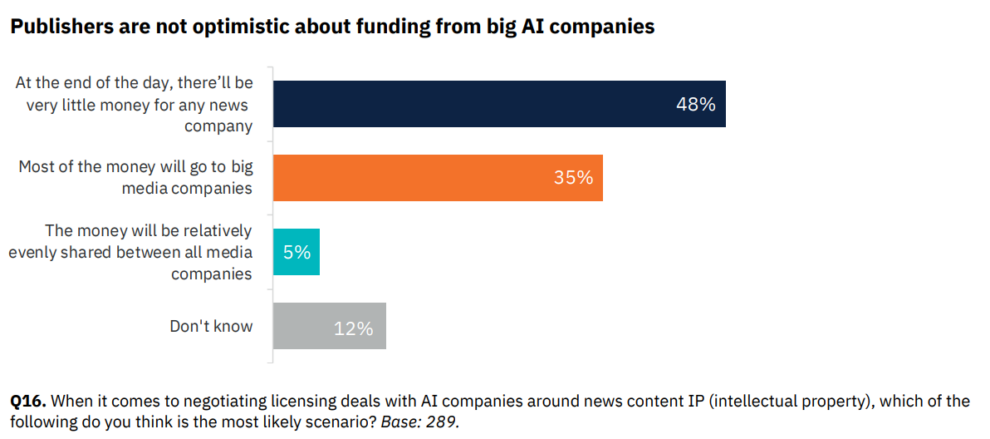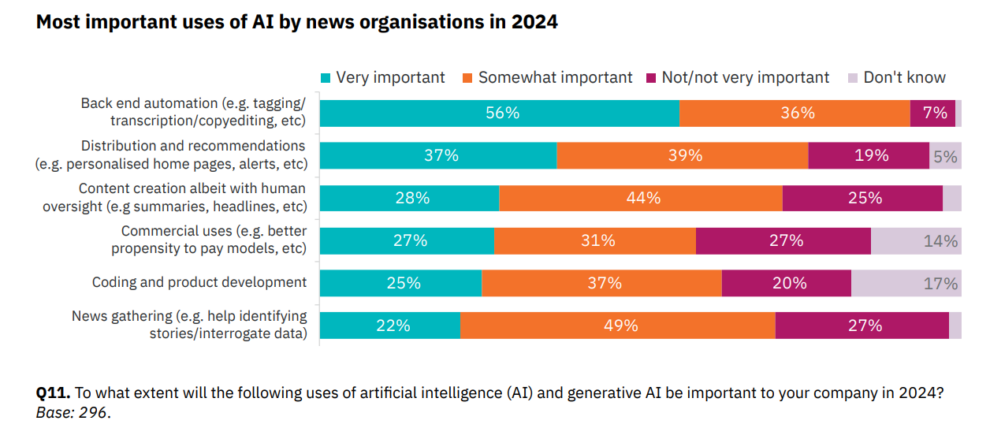2024 brings with it Reuters’ much-anticipated Trends and Predictions 2024 report. Compiled from the insights of over 300 news industry leaders across 50 countries, this report is a barometer for the challenges and expectations shaping journalism in the year ahead. In a year with over 40 elections and major events such as the Olympics, it is lining up to be a busy one for the news industry!
In this blog, we aim to deliver a succinct overview of the report’s most significant insights. Specifically, we highlight two overarching trends that stand out for their profound impact on the upcoming year: the advancements in AI technology and the evolving dynamics of news distribution channels.
Many thanks to Nic Newman and Eduardo Suarez for the advance copy of the report. It will well worth the full read.
Executive Summary
- AI Impact:
- AI technologies are reshaping newsrooms, leading to decreased direct website traffic and raising legal and content quality concerns.
- We can expect to see more publishers hiring AI specialists in addition to a rise in AI regulations in the year to come.
- Shift in Distribution
- A slow ad market, fewer direct referrals, and changes to some social media platform policies are leading publishers to shift their distribution channels, focusing more on direct messaging or video platforms.
- They are also creating more specialized and multimedia content to attract a loyal readership and establish direct connections with users.
AI remains in the spotlight of newsrooms
AI’s influence on the news industry is set to reach new heights in 2024. With three out of nine predictions in the Reuters Digital Report centered around AI, it becomes evident that this technology will continue playing a fundamental role in shaping the future of journalism. This section will outline what we can expect concerning AI in the coming 12 months.
Is this story capturing your attention?
"(Required)" indicates required fields
Direct traffic to news websites will keep declining because of generative search.
In 2024, the substantial decline in referral traffic for the news industry will continue, with the main culprit being Generative Search Experiences (GSEs). These AI-powered search engines and chatbots are altering how users get answers to their questions, often without citing their sources and thus diminishing direct traffic to news websites. As such, GSEs are contributing to news outlets facing challenges in attracting their audiences and monetizing their content.

News articles are a treasure trove of content for AI companies, as they can be used to train their models. However, a concern for many newsrooms is copyright infringement: the report suggests this will create a new legal battleground – intellectual property (IP) cases. Publishers increasingly seek compensation for the use of their content in AI training, leading to potential legal disputes between news organisations and AI companies (e.g., the New York Times’ lawsuit against OpenAI). However, even if AI companies were to pay out publishers, 48% of respondents were not optimistic about the tangible financial benefits they would receive. Indeed, The Information reported that OpenAI is offering “some media firms as little as between $1 million and $5 million annually to license their news articles for use in training its large language models”.

News organizations will continue to invest in AI internally.
The report suggests that news organizations will invest more heavily in backend AI technologies (56% of respondents believe this is very important). Additionally, we can expect these organizations to actively hire AI specialists to provide strategic direction for using the technology. In fact, according to the report, 16% already have an AI specialist on staff, and 24% plan to hire one this year.
37% of respondents believe using AI in news distribution and recommendations will be increasingly important. AI tools such as Twipe’s AI personalised newsletter recommendation system will see more growth in 2024.

A caveat to these investments that the report highlights is that newsrooms are cautious about content creation by AI due to perceived risks, particularly in maintaining the quality, authenticity, and trustworthiness of news articles generated by machines. Indeed, 56% of respondents noted that content creation carried the most significant reputational risk.
More regulations will be put in place to manage the increase in AI-generated content.
Despite the perceived reputation risk of producing AI-generated content, the report predicts that we will see its proliferation. In a year with over 40 elections set to happen, this had important implications, namely, AI-generated content’s role in spreading misinformation during campaigns. In 2023, AI imagery was already used to undermine candidates in Argentina, Slovakia, and the US. According to the report, “70% of respondents think that AI and Generative AI will, on balance, lower trust levels in the news overall” as more fake content is output alongside legitimate information.
To address this issue, we can expect to see more regulatory measures to govern AI-generated content in 2024. The European Union is already attempting to standardize and regulate AI content on digital platforms through its Digital Services Act and upcoming AI Act. However, the Reuters report suggests that comprehensive regulations will not be ratified and implemented in time for these key elections.
News distribution and consumption channels are set to change
Publishers are shifting away from Facebook and X.
In line with a trend which has been steadily continuing for several years, more publishers are turning away from Facebook and X (formerly Twitter) as changes to their policies have de-incentivized or inhibited the ability to link to news sites. This shift in social media dynamics has led to severe consequences for social media-based news sites (e.g., Buzzfeed, Vox, Vice), with some facing financial struggles and layoffs. Throughout the industry, financial difficulties have been compounded by an unstable and slow ad market, making only 47% of respondents confident about the year ahead.
That said, in a year of elections across the globe as well as the Olympics, we can expect an uptick in audience growth as more people tune into the news. Also, although Facebook and X are being deprioritized by publishers, the importance of direct messaging apps for new dissemination has risen, particularly as WhatsApp has enabled a feature within the app for large and direct distribution channels. Another noteworthy trend is the targeting of younger audiences on platforms such as YouTube and TikTok through short videos or video streams of podcasts. Indeed, it is expected that news organisations will focus more on multimedia content in 2024.

Publishers are exploring specialized content offerings to engage and retain customers.
Publishers are also diversifying their news products by offering “lite” versions (tailored for a younger audience who may not be able to pay) and increasingly offering specialized content (e.g., newsletters with a specific focus). The Financial Times, for instance, has launched a limited paid newsletter series about personal finance. This diversification allows them to cater to specific niches and demographics, potentially attracting a broader readership. Overall, there is a growing emphasis on direct traffic, enabling news organizations to establish direct connections with their users.
Conclusion
The 2024 landscape of news content is marked by the growing influence of AI, shifting ad markets, and innovative publisher strategies. While AI presents opportunities for automation and efficiency, it also raises concerns about content quality and regulatory challenges. Meanwhile, publishers are adapting to changes in referral traffic by diversifying their offerings and targeting new audiences. The news industry’s ability to navigate these transformations will be pivotal in determining its success in the years to come.
Did you find this story interesting?
"(Required)" indicates required fields
Other Blog Posts

Stay on top of the game
Join our community of industry leaders. Get insights, best practices, case studies, and access to our events.
"(Required)" indicates required fields

